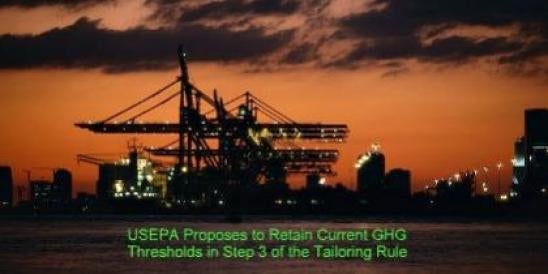As the D.C. Court of Appeals heard an unprecedented two days of oral argument on challenges to USEPA's suite of greenhouse gas ("GHG") regulations, USEPA issued an advance copy of yet another GHG regulation-the third step of its GHG permit Tailoring Rule ("Proposed Step 3 Rule"). Advance copy of Docket No. EPA-HQ-OAR-2009-0517 available at www.epa.gov/nsr/ghgdocs/
In 2010, USEPA committed to complete action on a Step 3 rulemaking by July 1, 2012, and to make Step 3 effective on July 1, 2013. Steps 1 and 2 of the Tailoring Rule were promulgated in May 2010, applying only to the largest sources of GHG emissions. In that rule, USEPA stated that it would take comment and consider whether to include smaller sources or lower the trigger for applicability in Step 3. In the Proposed Step 3 Rule, USEPA determined that "the permitting authorities are not significantly better positioned now" to process more GHG permits than they were in May 2010, so USEPA proposes to retain the current applicability thresholds promulgated under Steps 1 and 2.
The thresholds for determining GHG PSD applicability are as follows:
-
Step One:
- Starting January 2, 2011, GHGs must be addressed in Title V permits for all sources that are otherwise subject to Title V permitting requirements based on their emissions of non-GHG pollutants.
- In addition, PSD requirements apply to GHGs for projects that increase net GHG emissions by at least 75,000 tons per year ("tpy") carbon dioxide equivalent ("CO2e"), but only for projects that are "major modifications" as a result of an increase in emissions of a regulated, non-GHG pollutant.
-
Step Two:
- Starting July 1, 2011, some stationary sources that would not otherwise require Title V or PSD permits require such permits solely as a result of emitting GHGs.
- Stationary sources that emit or have the potential to emit at least 100,000 tpy CO2e (and 100 tpy GHGs on a mass basis) are subject to Title V permitting requirements.
- Stationary sources that emit or have the potential to emit at least 100,000 tpy CO2e (and 100 or 250 tpy GHGs on a mass basis, depending on the source) constitute "major stationary sources" under the PSD regulations. New stationary sources over the 100,000 tpy CO2e threshold are subject to PSD requirements for their GHG emissions. In addition, projects that increase net GHG emissions by at least 75,000 tpy CO2e are "major modifications" (assuming other elements are met and no exclusions apply), whether or not those projects would constitute "major modifications" based on an increase of any other pollutant.
USEPA also proposed two changes to streamline the permitting program under Step 3.
The first is to extend the use of the plantwide applicability limit ("PAL") to GHG permitting. The source would apply for a PAL that would apply to the entire source rather than specific emissions points. This alteration would allow facilities to alter emissions units without triggering new permitting requirements, provided that emissions levels do not exceed the PAL. The added flexibility allows companies to respond to changing market conditions while streamlining permitting.
The second change would create the regulatory authority for USEPA to issue synthetic minor permits for GHGs where the agency is the PSD permitting authority. Under this approach, a GHG source could agree to an enforceable GHG emissions limit set below a level that would trigger PSD permitting requirements. Such a limit might be an hourly or daily fuel consumption limit, for example. USEPA proposes to give itself and its designated agents the ability to issue synthetic minor permits for GHG and potential GHG emitters. USEPA stated that many state and local permitting authorities already have the ability to issue such synthetic minor permits.
The proposal solicits comments on whether streamlined approaches could be appropriate for some source categories and requests that commenters provide detailed proposals for those source categories. For example, general permits could be considered for some. USEPA solicits comments on which source categories would be candidates for the creation for a Potential to Emit ("PTE") specific rule or guidance; input on whether such a rule should target specific source categories or be made broadly available; and comments on the appropriate structure and requirements for such a rule.
The proposal requests comment on a number of other PSD program concepts, including permitting burden on state agencies, presumptive BACT and "empty" Title V permits. The proposal has not yet been published in the Federal Register but USEPA states that the comment period for the Proposed Step 3 Rule will end on April 20, 2012. A public hearing will be held on March 20, 2012 in Arlington, Virginia.
This brief summary does not address the many permitting decision nuances and requested comments reflected in the agency action, so careful reading of the proposed rule is suggested. For more information about the Tailoring Rule, please see our prior updates: "USEPA Issues Final Tailoring Rule" and"Greenhouse Gas Reporting and Permitting Deadlines in 2011".


 i
i


